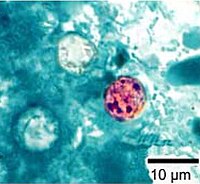
Photo from wikipedia
Sulfamethoxazole (SMX) is a commonly applied antibiotic for treating urinary tract infections; however, allergic reactions and skin eczema are known side effects that are observed for all sulfonamides. Today, this… Click to show full abstract
Sulfamethoxazole (SMX) is a commonly applied antibiotic for treating urinary tract infections; however, allergic reactions and skin eczema are known side effects that are observed for all sulfonamides. Today, this molecule is present in drinking and surface water sources. The allowed concentration in tap water is 2·10-7 mol L-1. SMX could unintentionally be ingested by healthy people when drinking contaminated tap water, representing unnecessary drug intake. To assess the quality of tap water, fast, specific and sensitive detection methods are required, in which consequence measures for improving the purification of water might be initiated in the short term. Herein, the quantitative detection of SMX down to environmentally and physiologically relevant concentrations in the nanomolar range by employing surface-enhanced Raman spectroscopy (SERS) and a microfluidic cartridge system is presented. By applying surface-water samples as matrices, the detection of SMX down to 2.2·10-9 mol L-1 is achieved, which illustrates the great potential of our proposed method in environmental science.
Journal Title: Analytica chimica acta
Year Published: 2017
Link to full text (if available)
Share on Social Media: Sign Up to like & get
recommendations!